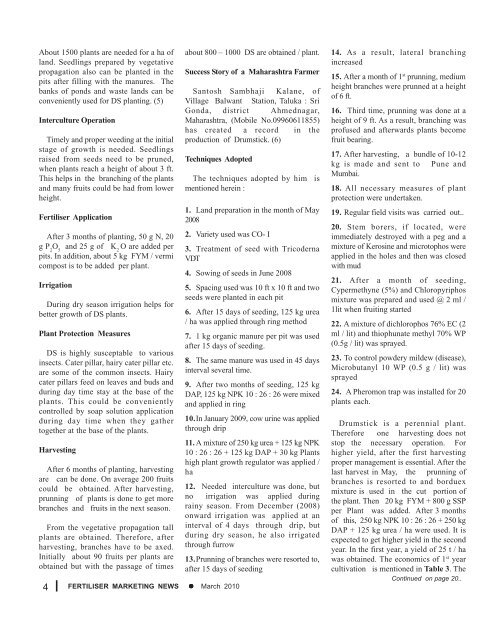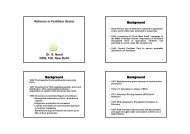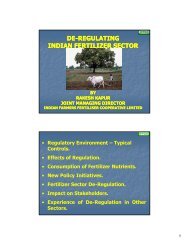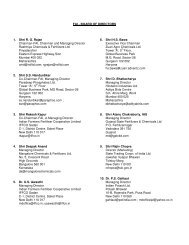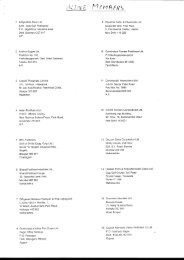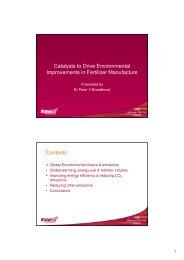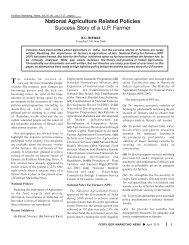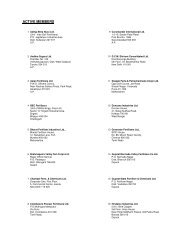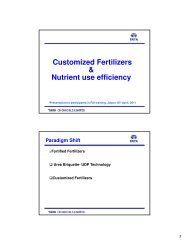Cultivation of Medicinal Plant Success Stories of Two Farmers
Cultivation of Medicinal Plant Success Stories of Two Farmers
Cultivation of Medicinal Plant Success Stories of Two Farmers
You also want an ePaper? Increase the reach of your titles
YUMPU automatically turns print PDFs into web optimized ePapers that Google loves.
About 1500 plants are needed for a ha <strong>of</strong>land. Seedlings prepared by vegetativepropagation also can be planted in thepits after filling with the manures. Thebanks <strong>of</strong> ponds and waste lands can beconveniently used for DS planting. (5)Interculture OperationTimely and proper weeding at the initialstage <strong>of</strong> growth is needed. Seedlingsraised from seeds need to be pruned,when plants reach a height <strong>of</strong> about 3 ft.This helps in the branching <strong>of</strong> the plantsand many fruits could be had from lowerheight.Fertiliser ApplicationAfter 3 months <strong>of</strong> planting, 50 g N, 20g P 2O 5and 25 g <strong>of</strong> K 2O are added perpits. In addition, about 5 kg FYM / vermicompost is to be added per plant.IrrigationDuring dry season irrigation helps forbetter growth <strong>of</strong> DS plants.<strong>Plant</strong> Protection MeasuresDS is highly susceptable to variousinsects. Cater pillar, hairy cater pillar etc.are some <strong>of</strong> the common insects. Hairycater pillars feed on leaves and buds andduring day time stay at the base <strong>of</strong> theplants. This could be convenientlycontrolled by soap solution applicationduring day time when they gathertogether at the base <strong>of</strong> the plants.HarvestingAfter 6 months <strong>of</strong> planting, harvestingare can be done. On average 200 fruitscould be obtained. After harvesting,prunning <strong>of</strong> plants is done to get morebranches and fruits in the next season.From the vegetative propagation tallplants are obtained. Therefore, afterharvesting, branches have to be axed.Initially about 90 fruits per plants areobtained but with the passage <strong>of</strong> times4FERTILISER MARKETING NEWS • March 2010about 800 – 1000 DS are obtained / plant.<strong>Success</strong> Story <strong>of</strong> a Maharashtra FarmerSantosh Sambhaji Kalane, <strong>of</strong>Village Balwant Station, Taluka : SriGonda, district Ahmednagar,Maharashtra, (Mobile No.09960611855)has created a record in theproduction <strong>of</strong> Drumstick. (6)Techniques AdoptedThe techniques adopted by him ismentioned herein :1. Land preparation in the month <strong>of</strong> May20082. Variety used was CO- I3. Treatment <strong>of</strong> seed with TricodernaVDT4. Sowing <strong>of</strong> seeds in June 20085. Spacing used was 10 ft x 10 ft and twoseeds were planted in each pit6. After 15 days <strong>of</strong> seeding, 125 kg urea/ ha was applied through ring method7. 1 kg organic manure per pit was usedafter 15 days <strong>of</strong> seeding.8. The same manure was used in 45 daysinterval several time.9. After two months <strong>of</strong> seeding, 125 kgDAP, 125 kg NPK 10 : 26 : 26 were mixedand applied in ring10.In January 2009, cow urine was appliedthrough drip11. A mixture <strong>of</strong> 250 kg urea + 125 kg NPK10 : 26 : 26 + 125 kg DAP + 30 kg <strong>Plant</strong>shigh plant growth regulator was applied /ha12. Needed interculture was done, butno irrigation was applied duringrainy season. From December (2008)onward irrigation was applied at aninterval <strong>of</strong> 4 days through drip, butduring dry season, he also irrigatedthrough furrow13.Prunning <strong>of</strong> branches were resorted to,after 15 days <strong>of</strong> seeding14. As a result, lateral branchingincreased15. After a month <strong>of</strong> 1 st prunning, mediumheight branches were prunned at a height<strong>of</strong> 6 ft.16. Third time, prunning was done at aheight <strong>of</strong> 9 ft. As a result, branching waspr<strong>of</strong>used and afterwards plants becomefruit bearing.17. After harvesting, a bundle <strong>of</strong> 10-12kg is made and sent to Pune andMumbai.18. All necessary measures <strong>of</strong> plantprotection were undertaken.19. Regular field visits was carried out..20. Stem borers, if located, wereimmediately destroyed with a peg and amixture <strong>of</strong> Kerosine and microtophos wereapplied in the holes and then was closedwith mud21. After a month <strong>of</strong> seeding,Cypermethyne (5%) and Chloropyriphosmixture was prepared and used @ 2 ml /1lit when fruiting started22. A mixture <strong>of</strong> dichlorophos 76% EC (2ml / lit) and thiophunate methyl 70% WP(0.5g / lit) was sprayed.23. To control powdery mildew (disease),Microbutanyl 10 WP (0.5 g / lit) wassprayed24. A Pheromon trap was installed for 20plants each.Drumstick is a perennial plant.Therefore one harvesting does notstop the necessary operation. Forhigher yield, after the first harvestingproper management is essential. After thelast harvest in May, the prunning <strong>of</strong>branches is resorted to and borduexmixture is used in the cut portion <strong>of</strong>the plant. Then 20 kg FYM + 800 g SSPper <strong>Plant</strong> was added. After 3 months<strong>of</strong> this, 250 kg NPK 10 : 26 : 26 + 250 kgDAP + 125 kg urea / ha were used. It isexpected to get higher yield in the secondyear. In the first year, a yield <strong>of</strong> 25 t / hawas obtained. The economics <strong>of</strong> 1 st yearcultivation is mentioned in Table 3. TheContinued on page 20..


